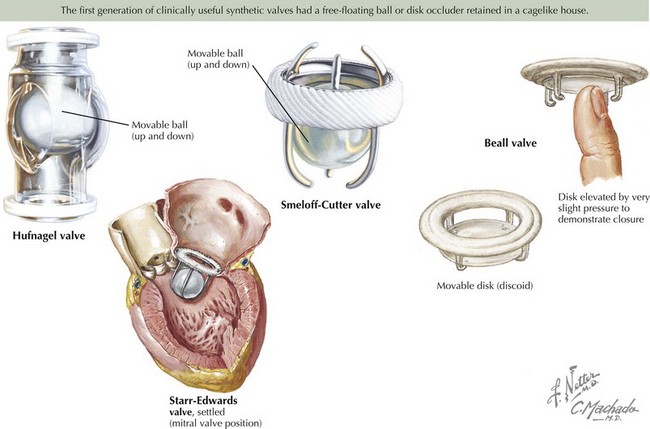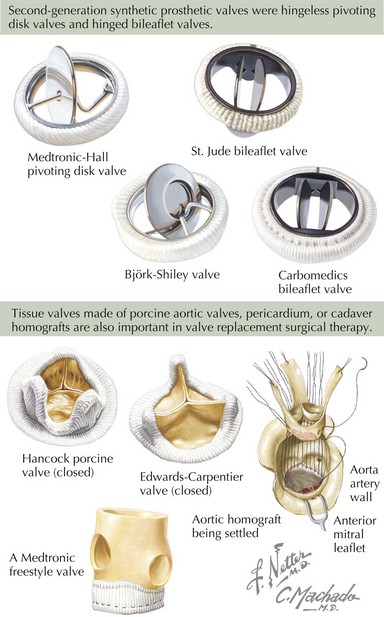41 Surgical Treatment of Valvular Heart Disease
Malfunction of any of the cardiac valves results in a less efficient circulatory system. Valvular dysfunction causes work overload in one or both ventricles. In extreme cases, resultant congestive heart failure can cause death. More information about etiology, pathogenesis, differential diagnoses, and diagnostic approaches used for evaluation of valvular diseases can be found in Chapters 34 to 40.
First-Generation Prosthetic Valves
Initial attempts to duplicate valve leaflets with flexible, nonbiologic materials failed. The leaflets of these valves were too stiff in comparison with normal valve leaflets. Efforts at using nonflexible leaflets by constructing hinged-valve leaflets resulted in hinge thrombosis and malfunction. Design engineers then focused on free-floating occluders, such as disks or balls retained in a cagelike housing. This general valve design produced the first clinically useful valves, including the Hufnagel, Starr-Edwards, Smeloff-Cutter, and Beall valves (Fig. 41-1). In 1958, the Starr-Edwards valve was used in the first clinically successful valve replacement.
Second-Generation Prosthetic Valves
The disadvantages of early prosthetic valves led to the development of two divergent lines of valve design using synthetic materials (mechanical valves) or biologic tissue (bioprosthetic valves). The caged-ball valves were modified, and pivoting hingeless disk valves, such as the Lillehei-Kaster, Medtronic-Hall, and Björk-Shiley valves, were developed. The St. Jude and Carbomedics valves were the first successful hinged-leaflet valves (Fig. 41-2, top).
Homograft valves harvested at autopsy and preserved in antibiotic solution or frozen were the first nonsynthetic valves to be implanted successfully. Their limited availability prompted the use of porcine valves procured from slaughterhouses. Porcine valves were preserved with glutaraldehyde and mounted on modified nylon-covered plastic or metal stents. Valves made of pericardium were also developed and used successfully (Fig. 41-2, bottom). Porcine and bovine pericardial valves are commonly used bioprosthetic valves today, whereas the hinged-leaflet valves are the commonly used mechanical valves.
Etiology and Pathogenesis
Cardiac valve pathology comprises two broad categories, congenital valve deformity and acquired valvular dysfunction. Congenital deformity can occur in one or more cardiac valves (see Section VIII). Patients with severe congenital valvular dysfunction can die if prompt surgical intervention is not undertaken. In patients with normally developed hearts, infection can cause valvular dysfunction at any age. Rheumatic heart disease secondary to untreated streptococcal infection and bacterial endocarditis can destroy a normal heart valve (Chapter 39
Stay updated, free articles. Join our Telegram channel

Full access? Get Clinical Tree




